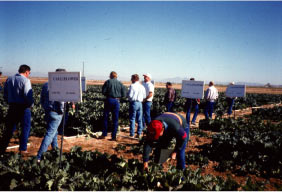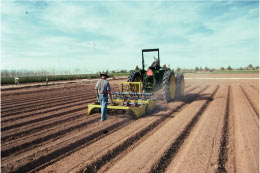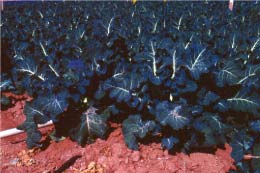|
Managing water and nutrients in vegetable crops |
||
|
Evaluation tools for growers By Joanne Littlefield and Susan McGinley
|
 |
Vegetable crop production in the arid Southwest requires continual irrigation and fertilizing. By managing water and nutrient applications correctly growers can not only save water but also reduce environmental impact. Nitrogen in particular is essential to productive plant growth, but applying more than crops will |
|
use can cause leaching from the soil profile and potential groundwater pollution. Growers need to manage nitrogen carefully because just as too much of it can leach into the groundwater, too little can decrease marketable yields. Drip irrigation is one way to put the nitrogen exactly where it is needed, without applying it in excess. Tom Thompson, an associate professor and soils specialist in the College of Agriculture and Life Sciences at the University of Arizona, has been studying drip irrigation and nutrient management in winter vegetables for the last ten years. He has conducted his research on broccoli, cauliflower and leaf lettuce on plots of one to four acres at the UA’s Maricopa Agricultural Center in central Arizona.
The ongoing studies have focused on irrigating daily through a buried drip system, and putting nitrogen into the drip tubing periodically, a practice called “fertigation.” Applying nutrients through the water enables growers to manage water and nitrogen simultaneously, a clear advantage for drip irrigation, according to Thompson. Since nitrogen requirements for drip-irrigated plants are usually less than for crops grown on traditional, furrow-irrigated beds, he is determining how often growers need to fertigate, and is establishing guidelines that can help growers determine the best inputs for their crop. “A broccoli crop, for example, needs about 350 pounds per acre of actual nitrogen over the growing season,” Thompson says. That’s the optimum amount, but periodic plant tissue tests during the growing season can help producers determine exactly how much nitrogen is needed (see sidebar). In addition to these tests, and to the grower’s own experience, Thompson suggests using soil-water tension readings to schedule irrigations. “By developing all of these guidelines for water management and nitrogen fertilizer management, we can add to the diagnostic tools growers need to maintain plant health,” he says. The bottom line is whether or not drip irrigation and fertigation result in a high-yield, high quality crop. According to Thompson, his research results confirm that high-yield agriculture is not incompatible with good environmental stewardship.
Drip irrigation has not fully caught on among Arizona vegetable growers because start-up costs are greater for drip than for furrow irrigation. Yet Thompson’s findings, and the experience of several pioneering Arizona growers such as Howard Wuertz in central Arizona, who have installed drip systems in their vegetable crops, indicate that drip irrigation eventually pays off. Wuertz has been using drip irrigation successfully on several vegetable crops for more than 20 years. “Although adoption of drip irrigation has been delayed by the
adverse farm economy of recent years, among other factors, I believe
that drip will play an important role in Arizona’s agricultural
future,” Thompson says. “While it requires more maintenance,
with drip it’s possible to use water and fertilizer inputs more
efficiently than in conventional production systems now in use. Furthermore,
our experiments and grower experience has shown consistently high crop
yield and quality with drip.” In the future, Thompson would like to put a permanent drip irrigation installation into a large experimental block at MAC that could be studied for perhaps ten years or more. It would be used not only for research, but also for demonstration purposes, to show how drip and nitrogen fertigation perform long-term in vegetable production. |

 “Our
analysis of the data over a ten-year period has shown that excellent
yields and economic returns can consistently be achieved with drip irrigation
systems, without polluting losses of nitrogen to the environment,”
he says. Drip systems also use approximately 20-50 percent less water
than conventional furrow irrigation.
“Our
analysis of the data over a ten-year period has shown that excellent
yields and economic returns can consistently be achieved with drip irrigation
systems, without polluting losses of nitrogen to the environment,”
he says. Drip systems also use approximately 20-50 percent less water
than conventional furrow irrigation.